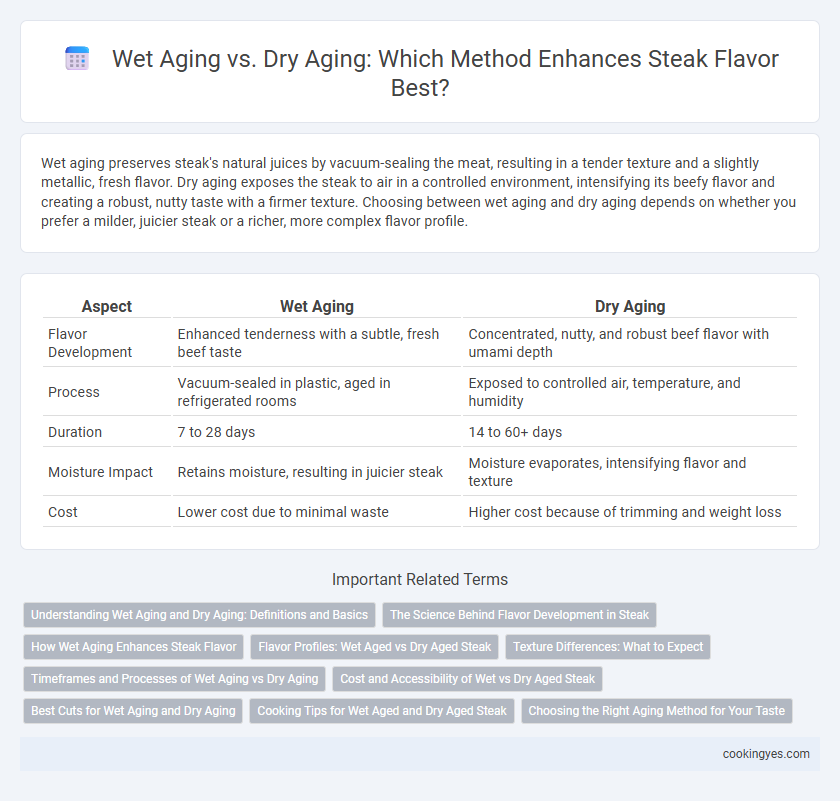Wet aging preserves steak's natural juices by vacuum-sealing the meat, resulting in a tender texture and a slightly metallic, fresh flavor. Dry aging exposes the steak to air in a controlled environment, intensifying its beefy flavor and creating a robust, nutty taste with a firmer texture. Choosing between wet aging and dry aging depends on whether you prefer a milder, juicier steak or a richer, more complex flavor profile.
Table of Comparison
| Aspect | Wet Aging | Dry Aging |
|---|---|---|
| Flavor Development | Enhanced tenderness with a subtle, fresh beef taste | Concentrated, nutty, and robust beef flavor with umami depth |
| Process | Vacuum-sealed in plastic, aged in refrigerated rooms | Exposed to controlled air, temperature, and humidity |
| Duration | 7 to 28 days | 14 to 60+ days |
| Moisture Impact | Retains moisture, resulting in juicier steak | Moisture evaporates, intensifying flavor and texture |
| Cost | Lower cost due to minimal waste | Higher cost because of trimming and weight loss |
Understanding Wet Aging and Dry Aging: Definitions and Basics
Wet aging involves vacuum-sealing beef to retain moisture, enhancing tenderness by enzymatic breakdown, while preserving a fresh, clean flavor profile. Dry aging exposes beef to controlled temperature and humidity, concentrating flavors through moisture evaporation and enzymatic processes, resulting in a nuttier, more intense taste. Both methods optimize beef quality, with wet aging emphasizing juiciness and dry aging focusing on complex, robust flavor development.
The Science Behind Flavor Development in Steak
Wet aging preserves steak in vacuum-sealed bags where natural enzymes break down muscle fibers, enhancing tenderness without significant moisture loss. Dry aging exposes steak to controlled air and humidity, promoting enzymatic breakdown and concentrated flavor through moisture evaporation and microbial action. The Maillard reaction during cooking further amplifies flavors in both methods by creating complex aroma compounds from amino acids and reducing sugars.
How Wet Aging Enhances Steak Flavor
Wet aging preserves steak flavor by enclosing the meat in vacuum-sealed packaging, preventing moisture loss and allowing natural enzymes to tenderize the muscle fibers. This process intensifies beef's savory umami notes while maintaining juiciness, resulting in a consistently rich and succulent taste. Wet aging typically requires less time than dry aging, offering a cost-effective method to enhance flavor without the complexity of external drying conditions.
Flavor Profiles: Wet Aged vs Dry Aged Steak
Wet aging steak enhances tenderness with a milder, more metallic flavor due to its anaerobic vacuum-sealed environment that retains moisture. Dry aging intensifies beef's flavor by exposing the meat to air, concentrating umami-rich compounds and developing nutty, earthy, and buttery notes through enzymatic breakdown and moisture evaporation. The contrast between wet-aged's juiciness and dry-aged's complex, robust flavor profiles defines their distinct culinary applications.
Texture Differences: What to Expect
Wet aging retains the steak's moisture, resulting in a more tender texture with less pronounced chew, while dry aging concentrates flavor and firms the meat through moisture evaporation. Dry-aged steaks develop a denser, slightly chewy texture with a crusty exterior that enhances flavor complexity. Understanding these texture differences helps select the ideal aging method for desired taste and mouthfeel in steak preparation.
Timeframes and Processes of Wet Aging vs Dry Aging
Wet aging involves sealing beef in vacuum-packed plastic for 7 to 28 days, allowing natural enzymes to tenderize the meat while retaining moisture and a metallic, slightly sour flavor. Dry aging, conducted in controlled humidity and temperature environments for 14 to 60 days, promotes enzymatic breakdown and moisture evaporation, intensifying beef's flavor with nutty, earthy, and umami notes. The longer dry aging periods result in a more complex, concentrated taste due to moisture loss and enzymatic reactions, while wet aging prioritizes tenderness and juiciness within a shorter timeframe.
Cost and Accessibility of Wet vs Dry Aged Steak
Wet aging is more cost-effective and accessible due to its shorter aging time and ability to be done in vacuum-sealed packaging, reducing the need for specialized storage facilities. Dry aging requires significant investment in controlled temperature and humidity environments, increasing overall costs and limiting availability primarily to high-end butcher shops and restaurants. Consequently, wet-aged steak is more widely available and affordable, while dry-aged steak caters to niche markets seeking intensified flavor profiles.
Best Cuts for Wet Aging and Dry Aging
Dry aging enhances flavor complexity and tenderness primarily in bone-in ribeye, strip loin, and sirloin cuts due to controlled moisture evaporation and enzymatic breakdown. Wet aging, which retains moisture by vacuum-sealing, is best suited for tender cuts like tenderloin and chuck, preserving juiciness while developing subtle flavor improvements. Selecting the right aging method depends on the desired taste profile and the specific muscle composition of each steak cut.
Cooking Tips for Wet Aged and Dry Aged Steak
Wet aging preserves moisture by vacuum-sealing the steak, resulting in a tender texture and milder flavor; cook wet-aged steak over medium-high heat to retain juiciness and avoid overcooking. Dry aging enhances flavor complexity through controlled dehydration and enzymatic breakdown, producing a nutty, concentrated taste; use high heat and shorter cooking times to achieve a flavorful crust while maintaining the interior. Rest dry-aged steaks briefly after cooking to allow juices to redistribute, maximizing tenderness and flavor intensity.
Choosing the Right Aging Method for Your Taste
Wet aging preserves steak tenderness by vacuum-sealing the meat, allowing natural enzymes to break down muscle fibers while retaining moisture. Dry aging exposes the steak to controlled temperature and humidity, intensifying flavor through moisture evaporation and enzymatic breakdown, resulting in a richer, beefier taste. Selecting wet or dry aging depends on your flavor preference: wet aging offers a juicier, milder profile, while dry aging delivers a concentrated, robust flavor ideal for steak enthusiasts.
Wet aging vs Dry aging for flavor development Infographic

 cookingyes.com
cookingyes.com